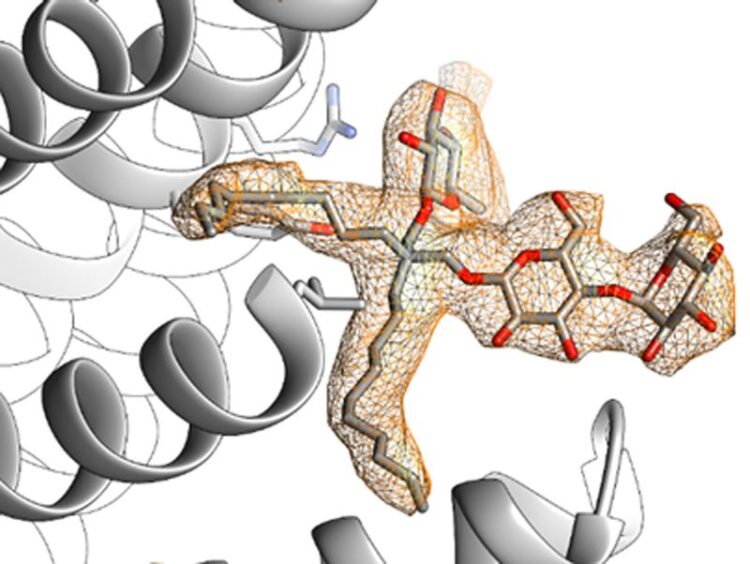Soap molecules open channel proteins extracted from the bacterial membrane

Die Abbildung zeigt die Bindung eines Seifenmoleküls (hellbraun) auf der Oberfläche des bakteriellen Kanals MscS (grau).
AG Böttcher RVZ Universität Würzburg
Soap molecules reversibly open specific channel proteins in bacteria. These channels are also interesting from a medical point of view, as they are part of the defense mechanisms of bacteria. A Würzburg research group published these results in the renowned journal PNAS.
Bacteria use special channel proteins through which they can channel fluid and ions out of the cell in case they need to protect themselves from bursting. The research group led by Prof. Dr. Bettina Böttcher of the Rudolf Virchow Center for Integrative and Translational Bioimaging at the University of Würzburg has now discovered that certain fat molecules (lipids), which build up the bacterial membrane, control the opening mechanism. Since harmful bacteria also use this protective mechanism, it is relevant to know the underlying mechanisms.
Washed off lipids lead to the opening
It was previously known that the mechanical tension of the membrane in which the channel proteins are embedded is measured by the proteins via “sensors” and leads to the opening of the channels when the tension is high. Böttcher and her group now showed that lipids attached to folds and pockets of the protein play an important role in the control. For this purpose, the scientists treated the samples, in which the proteins were present without a surrounding membrane, with different soap solutions. “The soap molecules slowly wash away the attached lipids, structural changes occur and the channels open. If more lipids are added again, the process is reversed and the channels close again,” Böttcher explains.
Students become Co-authors of the study
A special aspect of this study is the close link between research and teaching. The students of last year’s practical course “Electron Microscopy and Image Processing” took the measurements on the samples relevant for the study and thus contributed significantly to the publication. “Linking teaching and research is not always easy, as the research-relevant samples are more elaborate to prepare and riskier to study than typical samples used for internships” clarifies Böttcher. Julia Halang, one of the students says enthusiastically: “The internship gave me an insight into electron microscopy that I would never have had otherwise. We were allowed to do everything from sample preparation to image acquisition and processing. I am very grateful for that!”
Persons
Prof. Dr. Bettina Böttcher is Professor of Biochemistry and since 2016 head of a research group at the Chair of Biochemistry and at the Rudolf Virchow Center for Integrative and Translational Bioimaging at the University of Würzburg.
Dr. Tim Rasmussen works as a postdoc in the research group of Prof. Bettina Böttcher at the Rudolf Virchow Center for Integrative and Translational Bioimaging at the University of Würzburg.
Wissenschaftliche Ansprechpartner:
Prof. Dr. Bettina Böttcher (Rudolf Virchow Center, University of Würzburg)
Phone: +49 (0)931 31 84193, bettina.boettcher@uni-wuerzburg.de
Dr. Tim Rasmussen (Böttcher Group, Rudolf Virchow Center)
Phone: +49 (0)931 31 89659, tim.rasmussen@uni-wuerzburg.de
Originalpublikation:
Vanessa Judith Flegler, Akiko Rasmussen, Karina Borbil, Lea Boten, Hsuan-Ai Chen, Hanna Deinlein, Julia Halang, Kristin Hellmanzik, Jessica Löffler, Vanessa Schmidt, Cihan Makbul, Christian Kraft, Rainer Hedrich, Tim Rasmussen and Bettina Böttcher; Mechanosensitive channel gating by delipidation. PNAS (2021) doi: org/10.1073/pnas.2107095118
Weitere Informationen:
https://www.uni-wuerzburg.de/en/rvz/rvz-news/single/news/seifenmolekuele-oeffnen…
Media Contact
All latest news from the category: Life Sciences and Chemistry
Articles and reports from the Life Sciences and chemistry area deal with applied and basic research into modern biology, chemistry and human medicine.
Valuable information can be found on a range of life sciences fields including bacteriology, biochemistry, bionics, bioinformatics, biophysics, biotechnology, genetics, geobotany, human biology, marine biology, microbiology, molecular biology, cellular biology, zoology, bioinorganic chemistry, microchemistry and environmental chemistry.
Newest articles

Sea slugs inspire highly stretchable biomedical sensor
USC Viterbi School of Engineering researcher Hangbo Zhao presents findings on highly stretchable and customizable microneedles for application in fields including neuroscience, tissue engineering, and wearable bioelectronics. The revolution in…

Twisting and binding matter waves with photons in a cavity
Precisely measuring the energy states of individual atoms has been a historical challenge for physicists due to atomic recoil. When an atom interacts with a photon, the atom “recoils” in…

Nanotubes, nanoparticles, and antibodies detect tiny amounts of fentanyl
New sensor is six orders of magnitude more sensitive than the next best thing. A research team at Pitt led by Alexander Star, a chemistry professor in the Kenneth P. Dietrich…





















